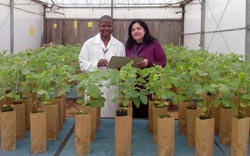Amaral Machaculeha Chibeba started his N2Africa PhD project in August 2012 at Londrina State University in Brazil. In summary, he characterized rhizobia isolated from field-grown soyabean nodules brought from Mozambique, conducted field trials for testing symbiotic effectiveness of elite Bradyrhizobium strains on soyabean in Brazil and Mozambique and conducted a greenhouse experiment to evaluate the effect of co-inoculation of soyabean with Bradyrhizobium and Azospirillum (a plant growth promoting rhizobacterium) on the earliness (precocity) of nodulation.
Genetic and symbiotic characterization of rhizobial strains
First, soyabean nodules from 15 locations in Mozambique were brought to Brazil. Amaral obtained 105 rhizobia isolates from these nodules. The DNA extractions, genomic profile by BOX-PRC, and 16S gene sequencing of the isolates pointed towards a large genetic diversity among the isolates. In addition, groups indicative of putative new rhizobia species were identified.
To assess the symbiotic effectiveness, Amaral first evaluated all 105 isolates on their effects on the Brazilian soyabean cultivar BRS 133, a non-promiscuous commercial genotype. He compared the effectiveness of the isolates with five elite Bradyrhizobium strains. Four of them are currently used in commercial inoculants in Brazil1 and one strain is broadly used in commercial inoculants in Africa and also in other experiments of the N2Africa project2.
| This first trial yielded 13 best isolates, which in turn formed the basis for another greenhouse experiment; this time with two promiscuous soyabean cultivars from Africa, TGx 1963–3F and TGx 1845–10E (Photo: Amaral Chibeba and Mariangela Hungria visiting the greenhouse experiment of evaluation of strains in soyabean promiscuous cultivars). |  |
If all goes according to plan, the results with the strains from Mozambique should be analysed by October 2015. As a next step, the elite strains from Mozambique that have already been identified will be tested in field experiments in Mozambique in the next crop season.
Technology transfer
In another study the objective was to verify if it is possible to transfer technology developed in Brazil with BNF straight to Mozambique. Amaral developed field trials with the same strains in both Brazil and Mozambique (2013/2014 and 2014/15 crop seasons): five in Brazil and eight in Mozambique. In Mozambique the trials were conducted with the support of Dr. Steven Boahen from IITA. The treatments consisted of the same elite Bradyrhizobium strains as in the greenhouse experiments. Some of the Brazilian strains, such as the SEMIAs 5079 and 5080, had an excellent performance in Mozambique. This shows the feasibility of transferring technology from Brazil to a country in Africa with similar edaphoclimatic conditions.
Precocity of nodulation
Another interesting topic to evaluate is the effect of co-inoculating soyabean. What happens to nodulation when you mix rhizobia and plant growth promoting rhizobacteria (PGPR)?Amaral carried out a greenhouse experiment in which he inoculated soyabean with both Bradyrhizobium and Azospirillum. It turned out that co-inoculation promotes precocity of nodulation. The results of this experiment have been published in the American Journal of Plant Sciences 6:1641-1649, 2015. Co-inoculation has potential to maximize biological nitrogen fixation in soyabean.
Amaral Chibeba (and Mariangela Hungria), Londrina State University, Brazil
1 Bradyrhizobium elkanii strains SEMIA 587 and SEMIA 5019 (=29w), B. japonicum SEMIA 5079 (=CPAC 15) and B. diazoefficiens SEMIA 5080 (=CPAC 7)
2 B. diazoefficiens USDA 110
